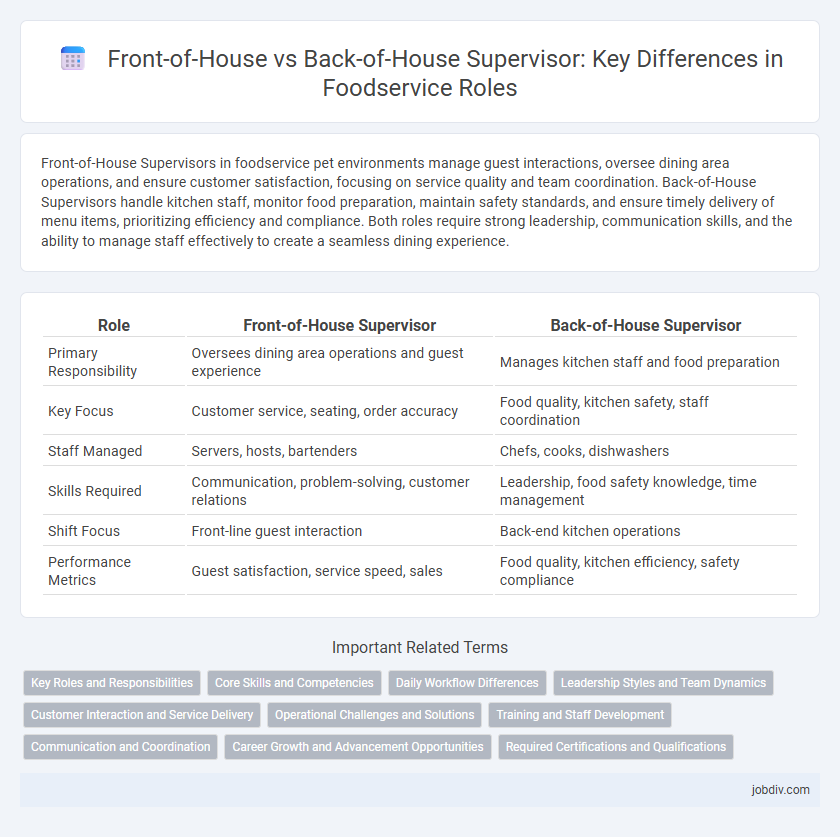Front-of-House Supervisors in foodservice pet environments manage guest interactions, oversee dining area operations, and ensure customer satisfaction, focusing on service quality and team coordination. Back-of-House Supervisors handle kitchen staff, monitor food preparation, maintain safety standards, and ensure timely delivery of menu items, prioritizing efficiency and compliance. Both roles require strong leadership, communication skills, and the ability to manage staff effectively to create a seamless dining experience.
Table of Comparison
| Role | Front-of-House Supervisor | Back-of-House Supervisor |
|---|---|---|
| Primary Responsibility | Oversees dining area operations and guest experience | Manages kitchen staff and food preparation |
| Key Focus | Customer service, seating, order accuracy | Food quality, kitchen safety, staff coordination |
| Staff Managed | Servers, hosts, bartenders | Chefs, cooks, dishwashers |
| Skills Required | Communication, problem-solving, customer relations | Leadership, food safety knowledge, time management |
| Shift Focus | Front-line guest interaction | Back-end kitchen operations |
| Performance Metrics | Guest satisfaction, service speed, sales | Food quality, kitchen efficiency, safety compliance |
Key Roles and Responsibilities
Front-of-House Supervisors manage dining room operations, including customer service, reservation coordination, and staff supervision to ensure a seamless guest experience. Back-of-House Supervisors oversee kitchen activities, focusing on food preparation, inventory management, and kitchen staff performance to maintain quality control and operational efficiency. Both roles require strong leadership and communication skills but differ significantly in daily tasks and operational focus within foodservice establishments.
Core Skills and Competencies
Front-of-House Supervisors excel in customer service, communication, and conflict resolution, ensuring a seamless guest experience and efficient seating management. Back-of-House Supervisors demonstrate strong leadership in kitchen operations, inventory control, and food safety compliance, maintaining high-quality food preparation standards. Both roles require teamwork, problem-solving abilities, and a deep understanding of restaurant protocols to optimize overall service delivery.
Daily Workflow Differences
Front-of-House Supervisors manage customer interactions, reservations, seating arrangements, and staff coordination, ensuring smooth service and guest satisfaction throughout the dining experience. Back-of-House Supervisors oversee kitchen operations, inventory management, food preparation, and compliance with health and safety standards to maintain efficient and high-quality meal production. The daily workflow contrasts with FOH concentrating on service optimization and BOH focusing on operational execution and food quality control.
Leadership Styles and Team Dynamics
Front-of-House Supervisors often employ transformational leadership to inspire customer-focused teams, emphasizing communication and service excellence. Back-of-House Supervisors rely on transactional leadership, prioritizing operational efficiency and strict adherence to food safety protocols. The dynamic between these roles ensures a balanced workflow, where FOH leaders enhance guest experience and BOH leaders maintain kitchen productivity.
Customer Interaction and Service Delivery
Front-of-House Supervisors oversee customer interaction, managing dining room staff, reservations, and guest satisfaction to ensure seamless service delivery. Back-of-House Supervisors focus on kitchen operations, coordinating food preparation, maintaining health standards, and ensuring timely order fulfillment. Both roles require strong leadership but differ in their direct engagement with customers and operational priorities within foodservice environments.
Operational Challenges and Solutions
Front-of-House Supervisors manage customer-facing operations, addressing challenges like staff coordination, guest satisfaction, and real-time problem-solving through proactive communication and efficient scheduling software. Back-of-House Supervisors face operational obstacles including inventory control, food safety compliance, and kitchen workflow optimization, which can be mitigated by implementing inventory management systems and standardized food preparation protocols. Both roles require tailored solutions to streamline operations, enhance team collaboration, and maintain high service standards in the foodservice industry.
Training and Staff Development
Front-of-House Supervisors emphasize customer service excellence, training staff in communication, hospitality, and conflict resolution to enhance guest experiences. Back-of-House Supervisors concentrate on developing kitchen staff skills in food preparation, safety protocols, and efficiency to maintain high operational standards. Both roles require targeted training programs tailored to their specific team needs, ensuring cohesive and well-rounded foodservice management.
Communication and Coordination
Front-of-House Supervisors excel in guest interaction and managing service staff, ensuring seamless communication between servers, hosts, and customers to enhance dining experience. Back-of-House Supervisors coordinate kitchen operations, maintain flow between chefs and food runners, and oversee food preparation timing to meet front-of-house demands. Efficient communication and coordination between both supervisors are critical for synchronizing customer service and kitchen performance in a foodservice environment.
Career Growth and Advancement Opportunities
Front-of-House Supervisors in foodservice often gain valuable leadership skills through direct customer interaction, which enhances their potential for advancement into managerial roles like Restaurant Manager or Sales Director. Back-of-House Supervisors develop expertise in kitchen operations, inventory management, and staff coordination, positioning them for career growth toward Executive Chef or Operations Manager roles. Both paths offer distinct advancement opportunities, with Front-of-House roles emphasizing guest experience and Back-of-House roles focusing on operational efficiency.
Required Certifications and Qualifications
Front-of-House Supervisors typically need certifications like ServSafe Food Handler and customer service training, while Back-of-House Supervisors require ServSafe Manager and often culinary qualifications. Front-of-House roles emphasize interpersonal skills and knowledge of health codes, whereas Back-of-House roles demand food safety expertise and kitchen management experience. Both positions benefit from supervisory experience and knowledge of local foodservice regulations.
Front-of-House Supervisor vs Back-of-House Supervisor Infographic

 jobdiv.com
jobdiv.com